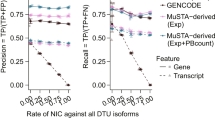Abstract
Objective
To determine whether large deletions or other alterations in the putative tumor suppressor gene TSG101 play a role in the molecular pathogenesis of breast and ovarian cancers.
Methods
Expression of TSG101 transcripts was examined in breast and ovarian cancers using the reverse transcriptase-polymerase chain reaction (RT-PCR), and selected transcripts were sequenced. Southern blot analysis was performed to determine whether there were genomic deletions in the TSG101 gene, and Northern blot analysis was used to examine the relative abundance of various transcripts.
Results
All the cancerous and normal breast tissue examined expressed full length 1145 base pair (bp) TSG101 transcripts. Additional truncated transcripts were seen using the RT-PCR in 57 (64%) of 89 primary breast cancers, 1 (20%) of 5 breast cancer cell lines, 3 (50%) of 6 normal breast tissues, 16 (64%) of 25 primary ovarian cancers and 1 (33%) of 3 ovarian cancer cell lines. Only the primary breast (21%) and ovarian (24%) cancers had three or more truncated transcripts. None of the normal tissues or cell lines examined had more than two aberrant transcripts. DNA sequencing revealed that the most commonly expressed truncated transcript arises because of loss of 902 bp between codons 153 and 1055. Only full length TSG101 transcripts were seen on Northern blot analysis of breast cancer cell lines, however. There was no evidence of genomic deletions in the TSG101 gene on Southern blot analysis.
Conclusion
Truncated TSG101 transcripts that probably represent splice variants are present in some breast and ovarian cancers, but there is no evidence to suggest that loss of this putative tumor suppressor gene plays a role in the molecular pathogenesis of these cancers.
Similar content being viewed by others
References
Berchuck A, Carney M, Lancaster JM, Marks J, Futreal PA. Familial breast-ovarian cancer syndromes: BRCAI and BRCA2. Clm Obstet Gynecol 1998; 41: 157–66.
Berchuck A, Elbendary A, Havrilesky L, Rodriguez GC, Bast RC. Pathogenesis of ovarian cancers. J Soc Gynecol Invest 1994; 1: 181–90.
Slamon DJ, Godolphn W, Jones LA, et al. Studies of HER–2/ Iel proto-oncogene in human breast and ovanan cancer. Science 1989; 244: 707–12.
Casey G, Lopez ME, Ramos JC, et al. DNA sequence analysis of exons 2 through 11 and immunohistothemical staining are required to detect all known p53 alterations m human malignancies. Oncogene 1996; 13: 1971–81.
Li L, Li X, Francke U, Cohen SN. The TSG101 tumor susceptibility gene is located in chromosome 11 band p15 and is mutated m human breast cancer. Cell 1997; 88: 143–54.
Li L, Cohen SN. TSG101: A novel tumor susceptibility gene isolated by controlled homozygous functional knockout of allelic loci m mammalian cells. Cell 1996; 85: 319–29.
Koonin EV, Abagyan RA. TSG101 may be the prototype of a class of dominant negative ubiquitin regulators. Nature Genet 1997; 16: 330–1.
Koi M, Johnson LA, Kalikin LM, Litde PER, Nakamura Y, Femberg AP. Tumor cell growth arrest caused by subchrorno-somal transferable DNA fragments from human chromosome 11. Science 1993; 260: 361–4.
Trail YK, Newsham IF. High density marker analysis of 11p15.5 in non-small cell lung carcinomas reveals allelic deletion of one shared and one distinct region when compared to breast carcinomas. Cancer Res 1996; 56: 2916–21.
Winqvist R, Hampton GM, Mannennaa A, et al. Loss of heterozygosity- for chromosome 11 in primary human breast tumors is associated with poor survival after metastasis. Cancer Res 1995; 55: 2660–4.
Weitzel JN, Patel J, Smith DM, Goodman A, Satan H, Ball HG. Molecular genetic changes associated with ovarian cancer. Gynecol Oncol 1994; 55: 245–52.
Zheng J, Wan M, Zweizig S, Velicescu M, Yu MC, Dubeau L. Histologically benign or low-grade malignant tumors adjacent to high-grade ovarian carcinomas contain molecular characteristics of high-grade carcinomas. Cancer Res 1993; 53: 4138–42.
Vandamme B, Lissens W, Amfo K, et al. Deletion of chromosome 11p13-11p15.5 sequences in invasive human ovarian cancer is a subclonal progression factor. Cancer Res 1992; 52: 6646–52.
Kiethele-Schwarz M, Bauknecht T, Wienker T, Walz L, Ptlei-derer. Loss of constitutional heterozygosity on chromosome 11p in human ovarian cancer. Cancer 1993; 72: 2423–32.
Maxwell PL, Feinberg AP. Aberrant splicing but no mutations of TSG101 in human breast cancer. Cancer Res 1997; 57: 3131–4.
Steiner P, Barnes DM, Hams WH, Weinberg RA. Absence of rearrangements in the tumor susceptibility gene TSG101 in human breast cancer. Nature Genet 1997; 16: 332–3.
Vaughn JP, Cirisano ED, Huper G, et al. Cell cycle control of BRCA2. Cancer Res 1996; 56: 4590–4.
Ilekis JV, Gamtu J, Niederberger C, Sciccia B. Expression of a truncated EGF receptor-like protein (TEGFR) in ovarian cancer. Gynecol Oncol 1997; 65: 36–41.
Cannistra SA, Abu-Jawdeh G, Niloff J, et al. CD44 variant expression is a common feature of epithelial ovarian cancer: Lack of association with standard prognostic factors. J Clin Oncol 1995; 13: 1912–21.
Murphy LC. Estrogen receptor variants in human breast cancer. Mol Cell Endocrinol 1990; 74: C83–6.
Lu M, Conzen SD, Cole CN, Arrick BA. Characterization of functional messenger RNA splice variants of BRCAI expressed in nonmalignant and tumor-denved breast cells. Cancer Res 1997; 56: 4578–81.
Thakur S, Zhang LIB, Peng Y, et al. Localizadon of BRCAI and a splice variant identifies the nuclear localizadon signal. Mol Cell Biol 1997; 17: 444–52.
Wilson CA, Payton MN, Elliott GS, et al. Differential subcellular localization, expression and biological toxicity of BRCAI and the splice variant BRCAI–11b. Oncogene 1997; 14: 1–16.
Author information
Authors and Affiliations
Additional information
Supported by grants CA55640 and the Duke Breast Cancer SPORE from the National Cancer Institute.
Rights and permissions
About this article
Cite this article
Carney, M.E., Maxwell, G.L., Lancaster, J.M. et al. Aberrant Splicing of the TSG101 Tumor Suppressor Gene in Human Breast and Ovarian Cancers. Reprod. Sci. 5, 281–285 (1998). https://doi.org/10.1177/107155769800500510
Published:
Issue Date:
DOI: https://doi.org/10.1177/107155769800500510




